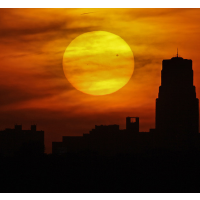Urban Heat Waves on the Rise; Extreme Wind Declines
 (AP photo)
(AP photo)
Life in big cities has become very heated thanks to a “double whammy” that includes more heat waves and less extreme winds, according to a new study.
Researchers in the United States and India examined 217 urban areas around the world and found that 48% of them endured heat waves from 1973 to 2012. At the same time, 60% of these cities witnessed a decline in extreme windy days.
“Our findings suggest that urban areas are experiencing a kind of double whammy — a combination of general climatic warming combined with the heat island effect, wherein human activities and the built environment trap heat, preventing cities from cooling down as fast as rural areas,” Dennis Lettenmaier, a coauthor of the study and a UCLA geography professor, said. “Everything’s warming up, but the effect is amplified in urban areas.”
Another researcher, Vimal Mishra, an assistant professor of civil engineering at the Indian Institute of Technology Gandhinagar, said: “The combination of higher temperatures and lower wind in particular is not a good combination for human health and well-being. This should concern everyone.”
The trend has been accelerated at night because all that concrete is holding in heat. Almost two-thirds of urban areas are experiencing hotter nights. “The fact that the trend was so much stronger at night underscores the role of the heat island effect in urban areas,” Lettenmaier said. “You have heat being stored in buildings and in asphalt, concrete and other building materials, and they don’t cool down as quickly as they would outside of the urban area. This effect was likely exacerbated by decreasing wind in most of the urban areas.”
Of the 40 years of climate information examined in the study, five years with the largest number of heat waves were identified—and four of those have happened in the last six years (2009, 2010, 2011 and 2012).
Cities in South America were found to have the greatest increase in heat wave frequency, followed by Africa, Europe, India and North America.
Heat waves were defined as periods in which the daily maximum temperature was hotter than 99 percent of days for the four-decade period and in which those temperatures were sustained for a consecutive period of six or more days.
-Noel Brinkerhoff, Steve Straehley
To Learn More:
Changes in Observed Climate Extremes in Global Urban Areas (by Vimal Mishra, Auroop Ganguly, Bart Nijssen and Dennis Lettenmaier, Environmental Research Letters)
Heat Waves Becoming More Prominent in Urban Areas, Research Reveals (by Meg Sullivan, UCLA)
Seven Degrees Hotter and Life on Earth Ends, Warns Kerry in Call to Action on Climate Change (by Steve Straehley, AllGov)
Temperatures Rising as Belief in Global Warming Drops (by Ken Broder, AllGov California)
- Top Stories
- Unusual News
- Where is the Money Going?
- Controversies
- U.S. and the World
- Appointments and Resignations
- Latest News
- What If China Invaded the United States?
- Donald Trump Has a Mental Health Problem and It Has a Name
- Trump Goes on Renaming Frenzy
- Trump Deports JD Vance and His Wife
- Trump Offers to Return Alaska to Russia






Comments